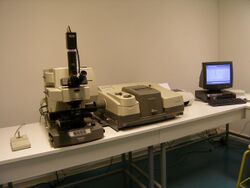National Centre for the Evaluation of Photoprotection
Topic: Organization
 From HandWiki - Reading time: 3 min
From HandWiki - Reading time: 3 min
This article has multiple issues. Please help improve it or discuss these issues on the talk page. (Learn how and when to remove these template messages)
(Learn how and when to remove this template message)
|
The National Institute for the Evaluation of Photoprotection (CNEP) is a research center dedicated to the study and analysis of plastic materials. Its focus lies in understanding the durability and identifying the failure mechanisms in these materials, which are primarily composed of polymers.
Overview
The center's research specializes in the safe and effective use of plastics in various applications. Key methods include conducting detailed physicochemical analyses to determine the causes of material failures. A significant part of this process involves the use of both artificial and natural aging tests to predict the long-term performance and stability of these materials. This research plays an essential role in enhancing the reliability and safety of polymer based products in everyday and industrial uses, including nanocomposite and composite materials with polymer matrix.
CNEP: A research center for the evaluation of polymer failures
(French) National Centre for the Evaluation of Photoprotection (CNEP)[3] is a subsidiary company of the University Blaise Pascal [4] created in 1986 by Professor Jacques Lemaire, former head of the Laboratory of Molecular and Macromolecular Photochemistry [5](LPMM) - Clermont-Ferrand (France). Initially, the goal was to transfer the expertise of LPMM on polymer photoaging to industrial companies facing increasing problems of degradation (yellowing, bleaching, physical property loss, etc.).
Today, CNEP is still associated with LPMM and with many small, medium, and world-size companies working in various domains of polymer applications.[1] More than 500 failure cases are examined yearly by CNEP, and over the last twenty years they have reviewed more than 100,000 different polymer formulations.
CNEP has progressively expanded its activities, utilizing sophisticated analytical tools for physicochemical analysis of polymer material failures, encompassing more than just aging-related degradation. Research is conducted under confidentiality agreements. For a decade, CNEP has held certification from the French Ministries as the National Centre for Technical Research (CRT). Serving as an interface, CNEP facilitates connections among polymer producers, transformers, and constructors, providing expertise across the entire plastic production chain.
CNEP is also applying basic concepts of photochemistry to suggest an original approach to the long-term prediction of plastic weathering. SEPAP units described elsewhere (weather testing of polymers and :fr:photovieillissement accéléré en SEPAP) provoke, in controlled accelerated relevant conditions, the same chemical evolutions as those which should occur at long term in weathering conditions. The SEPAP instrument was originally designed in the late seventies and built by ATLAS MTT in Germany. SEPAP units are now the base of many standard tests (see [6]).
CNEP approach
The CNEP approach considers that most initial polymer failures have a chemical origin that can be detected by specific analysis at the solid state. Among the extensive array of analytical techniques available at CNEP or on campus, methods such as non-destructive infrared and UV-Visible spectroscopy are notably well-established.
In the case of aging analysis, the knowledge of the chemical degradation mechanisms of most polymers allows following degradation at a very low extent both in natural and accelerated conditions.[2][3][4] Additional information could also come from the direct analysis of formulation compounds.
Additionally, CNEP is developing expertise in the analysis of the organic matters engaged in works of art[5][better source needed] as well as for the determination of common initial properties of polymers.[6]
See also
- Plastics
- Nanocomposite
- Composite materials
- Polymer
- Oxidation
- Polymer degradation
- Quality control
- Standardization
- Photochemistry
- Weather testing of polymers
- fr:Photovieillissement accéléré en SEPAP (French)
- Weathering
Notes and references
- ↑ transports, aeronautics, energy, building, agriculture, sports & leisure, electronics/electricity, electrical appliances, medical, packaging…
- ↑ Jacques Lemaire,"Predicting polymer durability" in Chemtech, October 1996, 42- 47.
- ↑ Jacques Lemaire; René Arnaud; Jean Luc Gardette; Jacques Lacoste; Henri Seinera (1986). "Zuverlässigkeit der Methode der photo-schnellalterung bei polymeren. ( Reliability of the accelerated photoaging method)". Kunststoffe, German Plastics (Int Ed.) 76: 149–153.
- ↑ Dr. Olivier Haillant, "Polymer Weathering: A Mix of Empiricism and Science", Atlas SunSpots Material Testing Product and Technology News, 2006, Vol. 36 Issue 76, 3-12 [1]
- ↑ painting, sculptures, archeological sites, monuments, contemporary art, modern and ancient papers, etc
- ↑ gas and water permeability, crystallinity, density, molecular weight, melt flow index, etc (see equipment list on [2])
 |
 KSF
KSF

